Rock art images often include unexpected and enigmatic elements. This study investigates the petroglyphs of especially anthropomorphic figures in the Majes Valley of southern Peru that have an unanticipated feather-element; a long groove (sometimes slightly curved) with a row of parallel but shorter grooves attached to one side only. This study will describe the petroglyphs of the several types of biomorphs featuring a feather-element, focussing however on the “Feathered Homunculus”, as well as their surprisingly limited distribution.
By Maarten van Hoek
*
*
The Enigma of the “Feathered Homunculus”
in the Rock Art of the Majes Valley, Peru
Maarten van Hoek – rockart @ home.nl
INTRODUCTION
Almost every rock art region in the Desert Andes, the extremely dry coastal strip to the west of the High Andes in South America, has its distinctive imagery. However, there is one rock art region (Arequipa in southern Peru and more specifically the Majes Valley), that has an above average number of often most idiosyncratic icons. One of those eccentric icons is the mammal that is depicted with an appendage what seems to be the feather of a bird. In this study a feather-element is characterised by a long groove (sometimes slightly curved) with a row of parallel but shorter grooves attached to one side only, ranging in number from two up to eight of such shorter grooves. Apart from having this unexpected and inexplicable component, rock art images of biomorphs with such a feather-element also have a remarkable distribution. This study will describe the rock art images of the several types of biomorphs featuring a feather-element, focussing on anthropomorphic figures, as well as their surprisingly limited distribution. Finally, throughout this study the prefixes “TM” and “PTM” (Proyecto Toro Muerto) refer to Toro Muerto, while the prefix “AP” refers to Alto de Pitis; an important rock art site only seven kilometres east of Toro Muerto, across the Majes Valley. The boulders at Toro Muerto are indicated by two letters (for instance Bc) referring to the Sector where they are found (for a location map of those Sectors see Figure 37) and a number: for example Boulder TM-Bc-044. When referring to a specific panel a capital letter is added: for example TM-Bc-044A.
However, in order to explain the enigmatic graphical context of especially the “Feathered Homunculus” one has to start with petroglyphs depicting birds. It will be no surprise that petroglyphs of birds often feature one (Figures 1.A and C) or two feather-elements (Figure 1.D), which, of course, are just representing the wings. Frontally depicted birds always have two wings, but profile birds usually have only one wing. However, there are several petroglyphs of profile birds at Toro Muerto that have two feather-elements, still depicting the two wings. In several cases the second feather-element emerges directly from the chest (a rather unnatural-looking position), which may mean that possibly it is a later addition (Figure 1.B). In fact, also when only one feather-element is present in a profile bird image, it may still be a later feature, especially in the Majes Rock Art Style (occurring in the area between the Caravelí drainage in the west and the Vítor Valley to the east).
Figure 1. Petroglyphs of birds. A: Boulder TM-Be-107; B and C: Boulder TM-Nw-20; D: Boulder TM-Bc-027. Photographs © by Maarten van Hoek.
Click any illustration to see an enlargement. Click again to return.
Surprisingly however, the feather-element also emerges at unexpected and illogical places from the bird’s body. On Boulder TM-Bc-028 (Figure 2.2) and on Boulder TM-Bc-036 (Figure 2.1A) the feather-element strangely emerges from the head, in the latter case even unnaturally from the forehead. Again, both feather-elements may have been added later. What is also remarkable is that on Boulder TM-Bc-036 two other biomorphs feature the feather-element: a quadruped (B) and an anthropomorph (C). These two categories will now be discussed.
Figure 2. Petroglyphs of birds and other biomorphs. 1: Boulder TM-Bc-036; 2: Boulder TM-Bc-028. Photographs and drawing © by Maarten van Hoek.
Only a relatively small number of the “Feathered Biomorphs” concern quadrupeds. In all cases those quadrupeds have been depicted fully laterally, having only one feather-element. It also seems that at Toro Muerto only one species of quadruped has been adorned with a feather-element. The quadruped on Boulder TM-Bc-036 (Figure 2.1B) is most likely a canine or a fox, but whatever the species, it is certain that the feather-element is an aberrant attribute, especially as the feather-element emerges from the top of the head; an unlikely position for a wing. There are several other instances where petroglyphs of quadrupeds show the “unnaturally” positioned feather-element, for instance on Boulder TM-Ac-003 (emerging from the single ear; Figure 3) and Boulder TM-Ba-010 (from one of the ears; Figure 3: inset A), on Boulders TM-Bc-010, Boulder TM-Bn-009, Boulder TM-Da-007 (Figure 3: inset B), Boulder TM-Db-001 (in all instances emerging from the head). On Boulder TM-Bf-078 a quadruped with a feather-element seems to be confronting or challenging a bird, while on the other side of the boulder are two puppet-like anthropomorphic figures with one feather-element each, henceforth labelled the “Feathered Homunculus” (Figure 4).
Figure 3. Petroglyph of the feathered quadruped on Boulder TM-Ac-003. Inset A: Boulder TM-Ba-10; Inset B: Boulder TM-Da-007. Photographs © by Maarten van Hoek.
It proves that petroglyphs of anthropomorphs are relatively much more attributed with a feather-element than birds and quadrupeds, and – moreover – their headgear often appears to be more complex in design. There are two categories of anthropomorphic figures with a feather-element; the Majes “Dancer” and the Majes “Feathered Homunculus”. Excluded in this study are two probably unique petroglyphs of anthropomorphs that also feature the feather-element, but in those two cases those two feather-elements most likely represent the wings of a bird, mainly because they emerge from both sides of the body, not from the head. One example (notice the face-less head) is found on Boulder TM-Be-056 and may be related to the Avian Staff Bearer icon of the Andes (Van Hoek 2016: 60; Figs 98 to 100; Figure 5A). The other example (also face-less) has been recorded at Toro Muerto by James Posso Sánchez from Arequipa and may also be related to the Avian Staff Bearer (Figure 5B).
Figure 4. Two petroglyphs of the “Feathered Homunculus” on Boulder TM-Bf-078. Photograph © by Karolina Juszczyk of the Proyecto Toro Muerto (Instituto de Estudios Ibéricos e Iberoamericanos, University of Warsaw, Poland).
The Majes “Dancer” is the most characteristic icon of Toro Muerto and Alto de Pitis (ignoring six simple examples in the Vítor Valley further east; Van Hoek 2018). I estimate the number of Majes “Dancers” that I have inspected at both sites to total more than 1100 examples. However, I know of only two instances (occurring on Boulders TM-Aa-035A and TM-Bf-009) where Majes “Dancers” feature the typical feather-element (Figure 6). However, also in those two instances the feather-element may represent a later addition. It proves that the “Feathered Dancer” is unique for Toro Muerto.
Figure 5. A: Petroglyph of a winged (?) anthropomorph on Boulder TM-Be-056. Photograph © by Maarten van Hoek. B: Petroglyph of a winged (?) anthropomorph on a boulder at Toro Muerto. Drawing © by Maarten van Hoek, based on a photograph by James Posso Sánchez from Arequipa.
Figure 6. A: Petroglyph of a “Feathered Dancer” on Boulder TM-Aa-035A. B: Petroglyph of a “Feathered Dancer” on Boulder TM-Bf-009. Photographs © by Maarten van Hoek (much enhanced).
The most enigmatic category of the “Feathered Mammal” has been labelled the “Feathered Homunculus” by me because of the general small dimensions and puppet-like appearance of this enigmatic anthropomorphic figure (Homunculus means “little person” in Latin). For instance, the small “Feathered Homunculus” on Boulder TM-Ba-013 measures only 15 cm in height (including the appendage from the head), while the wide-spread legs are only 13 cm apart (Figure 7). Those figures are labelled “chamanes” in the web site of the “Proyecto Toro Muerto (PTM)”, although not consistently. Of the 26 PTM entries labelled “chamanes” several figures do not even feature biomorphs (thus not even anthropomorphs) with the feather-element. In several cases only Majes “Dancers” (without any feather-element, though) appear on the rock’s surface, for instance on Boulders PTM-0029, PTM-0121 and PTM-0361. Therefore, I recommend that the PTM introduces several more categories in their future Data Base.
Figure 7. Petroglyph of a “Feathered Homunculus” on Boulder TM-Ba-013. Photograph © by Maarten van Hoek.
Before discussing the several graphical manifestations of the “Feathered Homunculus”, it must be mentioned that in Majes rock art similar puppet-like anthropomorphic figures without the characteristic feather-element also appear, for instance the examples without any apparent feather-like appendage on Boulder TM-Bc-038 (with one outlined, circular eye and a serpentine “tear”), Boulder TM-Db-019 (Figure 8) and Boulder TM-Ac-014, while Petroglyph D on Boulder TM-Bc-036 has only two short parallel incised lines emerging from the top of its head (see Figure 2).
Figure 8. Petroglyphs of puppet-like anthropomorphic figures on Boulder TM-Db-019. Photograph © by Maarten van Hoek.
Although the “Feathered Homunculus” is always a complete figure, there is only one exception known to me. It concerns the head-only petroglyph (having arms?) of a “Feathered Homunculus” on Panel TM-Ac-001A. It has three appendages from the head: a feather-element, a rake and a single line (Figure 9). It seems to hold some unknown object in its right hand. Because of the lay-out of the head (with two eyes, each with a double tear-element), this petroglyph is also admitted as a “Feathered Homunculus”.
Figure 9. Petroglyph of an incomplete “Feathered Homunculus” on Boulder TM-Ac-001A. Photograph © by Maarten van Hoek.
Although most petroglyphs of the “Feathered Homunculus” are fully frontally depicted, there are some relatively rare instances of examples that are laterally depicted. In those cases the figure has always only one arm and – in most cases – two legs that are completely touching each other, like the very simple and small examples on Boulders TM-Sw-002B and TM-Da-079 and the more sophisticated example on Boulder TM-Ac-014 (Figure 10A). The latter example has three dots as body decoration, a mouth that is oddly positioned sideways and two dots for eyes, one of which has a single tear-element.
The examples on Boulder TM-Bc-008 (see Figure 13: orange arrow and inset) and on Panel TM-Da-047A (Figure 10B) seem to have only one leg. In most cases laterally depicted examples of the “Feathered Homunculus” have only one feather-element, but the example on Boulder TMP-0445 is exceptional as it has two feather-elements, closed legs and possibly two arms (Figure 11).
Figure 10. A: Petroglyph of a “Feathered Homunculus” on Boulder TM-Ac-014; B: on Boulder TM-Da-047A. Inset: Petroglyph of a “puppet” with possibly obliterated face. Photographs © by Maarten van Hoek.
Figure 11. Petroglyph of a “Feathered Homunculus” on Boulder TMP-0445 (yellow arrow; notice the possibly related petroglyphs: orange arrows). Photograph © by Karolina Juszczyk of the Proyecto Toro Muerto (Instituto de Estudios Ibéricos e Iberoamericanos, University of Warsaw, Poland).
Perhaps the most sophisticated image of the “Feathered Homunculus” (on Boulder TM-Cd-019) appears next to a fully frontally depicted example without nonetheless a feather-element. The “Feathered Homunculus” on this boulder is special because of its rich decoration all over its body, its large arms with digits and for having its legs very tightly put together, which is in fact a feature of laterally depicted examples. Its feather-element (added later?) is a bit hard to see in Figure 12 and its facial features are either weathered or ritually obliterated.
Figure 12. Petroglyph of a “Feathered Homunculus” on Boulder TM-Cd-019 (the feather-element: yellow arrow; notice the related puppet-like petroglyph to its left). Photograph © by Maarten van Hoek.
However, most examples of the “Feathered Homunculus” are fully frontally depicted and always have two distinctly separated legs that are often spread wide open (with an angle of 25o and even up to 180 o). In several other cases the legs are vertically and parallel arranged without touching each other. They also have always two arms that in general may have two different positions: both arms raised, or one arm raised and the other arm drooping. Digits are hardly ever indicated.
There are examples of the frontally depicted “Feathered Homunculus” with only one feather-element, like the examples on Boulders TM-Bc-001, TM-Bc-009 and Boulder TM-Bc-010 (Figure 13), on Panel TM-Bs-004A (Figure 14), Boulder TM-Nw-067 (Figure 15) and Boulder TM-Bc-064 (Figure 16) where each time the single feather-element emerges from the very top of the head. The example on Boulder TM-Bc-010 may be associated with a snake. In one or all cases the feather-element may have been added later.
Figure 13. Petroglyph of a “Feathered Homunculus” on Boulder TM-Bc-010 (yellow arrow, possibly associated with a snake; also notice the two related images indicated by the golden arrow and the green arrow: see green-framed inset). Orange inset: Detail of the “Feathered Homunculus” on Boulder TM-Bc-008. Photos © by Maarten van Hoek.
Figure 14. Petroglyph of a “Feathered Homunculus” on Boulder TM-Bs-004 (notice the possible association with a snake). Photograph © by Maarten van Hoek.
Figure 15. Petroglyph of a “Feathered Homunculus” on Boulder TM-Nw-067. Photograph © by Maarten van Hoek.
Figure 16. Petroglyph of a “Feathered Homunculus” on Boulder TM-Bc-064 (notice the possible association with a snake; a fertility connotation?). Photo © by Maarten van Hoek.
The examples on Panel TM-Bs-004A and Boulder TM-Bc-064 are possibly associated with a snake petroglyph, the snake in the latter case seemingly reaching for or aiming at the genital area of the puppet. On Boulder TM-Bg-018 is a row of three stacked examples of the “Feathered Homunculus”, two of which each have one feather-element from the side of the head (Figure 17). All three have their legs spread wide-open, but the third puppet has lost its head and thus possibly its feather-element as well (probably due to quarrying). Also the two examples of the “Feathered Homunculus” on Panel TM-Bf-078, Boulder TM-Ba-013 (see Figure 7) and the one on TM-Boulder Bc-036 (see Figure 1C) have their feather-element from the side of their heads.
Figure 17. Two or three petroglyphs of a “Feathered Homunculus” on Boulder TM-Bg-018. Inset: the same three petroglyphs under different light. Photographs © by Maarten van Hoek.
A very special and possibly unique example of the “Feathered Homunculus” is the petroglyph on top of Boulder TM-Dx-010 (Figure 18). It has one feather-element and one serpentine groove emerging from its head and, although its pose it that of a living human, the short lines indicating the rib cage and the knee-joint prove that it is an example of a “Carcancha”, a Skeleton-Anthropomorph, thus combining and symbolising the all-important Andean life and death duality (Van Hoek 2013; 2018; 2020: Fig. 2).
Figure 18. Petroglyph of a “Feathered Homunculus” / ‘Carcancha’ on Boulder TM-Bc-064. Photographs © by Henry Reichlen (stored at the Musée de Quai Branly, Paris, France; 1965).
Very rarely examples of the “Feathered Homunculus” with one and with two feather-elements occur on the same panel, like the two petroglyphs on Boulder TM-Bc-051 (Figure 19). But more often examples of the “Feathered Homunculus” appear singly on one panel, like the petroglyphs on Boulders TM-Ac-015 (Figure 20A), TM-Bc-023 (Figure 20B) and TM-Cw-001 (Figure 20C). The example in Figure 20B has an extra feature (indicated by the yellow arrow) that will be discussed below. The example (with two tear-elements) on Panel TM-Bf-048C might also represent a “Carcancha” (though less clear as the example in Figure 18) and may also be associated with the snake hovering over its feather-elements (Figure 21). It seems that the “Feathered Homunculus” is more often associated with snake imagery (Figures 14 and 16).
Figure 19. Two petroglyphs of the “Feathered Homunculus” on Boulder TM-Bc-051. Photograph © by Maarten van Hoek.
Figure 20. A: Petroglyphs of the “Feathered Homunculus” on Boulder TM-Ac-015. B: Boulder TM-Bc-023. C: Boulder TM-Cw-001. Photographs © by Maarten van Hoek.
Figure 21. Petroglyph of a “Feathered Homunculus” on Boulder TM-Bf-048C. Photograph © by Maarten van Hoek.
Examples of the “Feathered Homunculus” with more complex or deviant headgear also occur. They all concern fully frontally depicted examples, having three or more appendages from the head. Some have one feather-element, like the incomplete example on Panel TM-Ac-001A (see Figure 9), while others have two feather-elements, like the examples on Boulder TM-Fa-004. On Panel TM-Fa-004A is a very small, possible example of a “Feathered Homunculus” and a much larger “Feathered Homunculus” with two feather-elements (one partially executed on a different panel) and a short line in between (Figure 22A), while Panel TM-Fa-004B has a similar example with a double rake element between the two feather-elements (Figure 22B). On Boulder TM-Fx-001 is a “Feathered Homunculus” with one feather-element and six slightly splayed, incised grooves from its head (only faintly visible), plus an extra feature (yellow arrows in Figure 23) that will be discussed below. Again it may be associated with a snake (orange arrow in Figure 23).
Figure 22. Petroglyphs of a “Feathered Homunculus” on Boulder TM-Fa-004. Photographs © by Maarten van Hoek. Drawing © by Maarten van Hoek, based on a photograph by Karolina Juszczyk of the Proyecto Toro Muerto (Instituto de Estudios Ibéricos e Iberoamericanos, University of Warsaw, Poland).
Figure 23. Petroglyph of a “Feathered Homunculus” on Boulder TM-Fx-001. Inset: Detail of the same “Feathered Homunculus”. Photographs © by Maarten van Hoek.
Definitely related to the “Feathered Homunculus” are figures that are lacking the typical feather-element, but instead feature different appendages from the head. An example – found on Boulder TM-Dx-093 (only 50 m NW of TM-Dx-010) – features four appendages, three of which are cross-shaped (Figure 24). On Boulder TM-Ac-008 is a rather large example with three appendages (Figure 25); one cross-shaped, another being a rake-element similar to the one on Boulder TM-Ac-001 (see Figure 9). It may well be the largest example of the “Feathered Homunculus” as it measures 72 cm in height.
Figure 24. Petroglyph of a “Feathered Homunculus” on Boulder TM-Dx-093. Drawing © by Maarten van Hoek, based on the photo of Figure 24; © by Karolina Juszczyk of the Proyecto Toro Muerto (Instituto de Estudios Ibéricos e Iberoamericanos, University of Warsaw, Poland).
Figure 25. Petroglyph of a large “Feathered Homunculus” on Boulder TM-Ac-008. Photograph © by Maarten van Hoek.
Figure 26. Two petroglyph of the “Discharging Homunculus” at Toro Muerto. Photograph © by Henry Reichlen (stored at the Musée de Quai Branly, Paris, France; 1965).
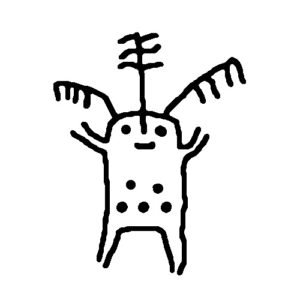 THE “DISCHARGING FEATHERED HOMUNCULUS”
THE “DISCHARGING FEATHERED HOMUNCULUS”
Although extremely rare, the “Discharging Homunculus” is definitely related to the “standard” “Feathered Homunculus”. It concerns a similarly designed puppet-like figure with, however, a special feature. From one or from both arms emerges a row of small dots or cupules, as if bullets are being fired. An example – without a feather-element, though – is found on Boulder TM-Bc-007. Henry Reichlen photographed a panel at Toro Muerto where two puppet-like anthropomorphs clearly are emitting three cupules from their arms (Figure 26). Although they have no feather-element, they have the same layout and, moreover, at Toro Muerto there are convincing parallels of “discharging” figures with a feather-element.
For instance, already mentioned is the “Feathered Homunculus” on Boulder TM-Fx-001 with its rayed head, but it is also special because it has an arm that seems to discharge “bullets” (see Figure 23; yellow arrows). Another fine example of the ” Discharging Feathered Homunculus” is found on Boulder TM-Bc-003, where a simple “Feathered Homunculus” discharges a row of four “bullets” towards a large quadruped, although the association between the two is (most!) uncertain (Figure 27). On Boulder TM-Bc-023 a row of four “bullets” emerges from one of the arms (see Figure 20B), while also the “Feathered Homunculus” on Boulder TM-Bc-036 (Petroglyph C) emits four “bullets” from one of its arms (indicated by an arrow in Figure 2). On Boulder TM-Aa-058 are no less than two petroglyphs depicting a “Feathered Homunculus” and both seem to emit “bullets” from both their arms. Unfortunately the two petroglyphs are more deeply patinated and do not show clearly in my 2002-photograph (Figure 28). Just possibly the “Discharging Feathered Homunculus” is somehow related to the Majes “Spitter” icon that also emanates drops (from the mouth, though).
Figure 27. Petroglyph of a “Discharging Feathered Homunculus” on Boulder TM-Bc-003. Photographs © by Maarten van Hoek.
Figure 28. Two petroglyphs of a “Discharging Feathered Homunculus” on Boulder TM-Aa-058. Photograph © by Maarten van Hoek.
Although I am not aware of any convincing example of the “Feathered Homunculus” to exist at the extensive rock art site of Alto de Pitis on the other side of the valley, opposite Toro Muerto, there are two boulders featuring petroglyphs that are perhaps comparable with the “Discharging Feathered Homunculus”. On Boulder AP2-014 is a single, puppet-like anthropomorphic figure, without a feather-element, though, having more or less the same layout as the profile “Feathered Homunculus”, but instead of “bullets” a groove seems to be emerging upwards from the end of its single arm (Figure 29A). On nearby Boulder AP2-012 is a collection of six much weathered anthropomorphic figures, four of which resemble frontally depicted puppets, while one example may depict a profile puppet. At least two of this group (perhaps more) also have a small groove emerging upwards from an arm (arrows in Figure 29B). Further north of Boulder AP2-014 not a single “Feathered Homunculus” has been noticed by me. The only puppet-like petroglyph (without the feather-element, though) I am aware of appears on Panel AP3-170A.
Figure 29. A: Petroglyph of a possibly “Discharging Homunculus” on Boulder AP2-014 at Alto de Pitis. B: Boulder AP2-012. Photos © by Maarten van Hoek.
 THE OBLITERATED “FEATHERED HOMUNCULUS”
THE OBLITERATED “FEATHERED HOMUNCULUS”
One of the important aspects of the rock art of Toro Muerto and Alto de Pitis is that a considerable number of petroglyphs clearly has ritually been obliterated by later prehistoric rock art manufacturers. It mainly concerns the (often partial) obliteration of the Majes “Dancer”, camelids, snakes and especially felines (Van Hoek 2021). Moreover, it mainly is the head of the petroglyph that has been erased, although completely obliterated examples also occur. To explain this practice I once argued that “the careful removal of especially the facial details must have been most meaningful and might have conveyed a very specific emotion. This sentiment might be an articulation of discontent about the desired effects of the imagery.”(Van Hoek 2005: 80).
In this respect it is surprising to see that in some cases also the “Feathered Homunculus” has been the target of ritual obliteration. An old photograph (stored at the Musée de Quai Branly, Paris, France; 1965) by Henry Reichlen, a Swiss archaeologist, clearly shows a probably laterally depicted example of a “Feathered Homunculus” of which the entire body has been erased, only leaving the feather-element exposed (on purpose?) (Figure 30). Again the figure may be associated with the snake petroglyph. A puppet-like figure without a feather-element on Boulder TM-Ac-014 (also featuring the petroglyph of a true “Feathered Homunculus”; see Figure 10: inset) has possibly all its facial features intentionally erased.
Figure 30. Petroglyph of an obliterated “Feathered Homunculus” at Toro Muerto. Photograph © by Henry Reichlen (stored at the Musée de Quai Branly, Paris, France; 1965).
The following three examples are somewhat doubtful, as it cannot be decided whether the fully pecked body-parts were originally intended this way, or that they were ritually obliterated at a later stage. It concerns two examples of the “Feathered Homunculus” on Boulder TM-Cd-033. Especially Petroglyph A on this boulder (Figure 31A) has deeply incised grooves representing arms and legs, while its feather-element is relatively larger and more crudely executed (a later addition?). Remarkably, the body and the head are fully pecked (or ritually obliterated), while other examples of the “Feathered Homunculus” at Toro Muerto usually feature facial features and body-decoration in the form of simple cupules and/or small grooves. The second example, Petroglyph B on the same panel, is almost similar; it also has its body and head fully pecked or ritually obliterated. The third example is found on Boulder TM-Da-010. It is special as it seems that its head (yellow arrow) and the feather-element (orange arrow) have ritually been obliterated (Figure 32). Also an object (?) held in its left hand (green arrow) seems to have been erased. A similar “intact” object – that is possibly directly associated with the icon of the “Feathered Homunculus” – is found on Boulder TM-Ac-001 (green arrow in Figure 9).
Figure 31. Petroglyph of a “Feathered Homunculus” on Boulder TM-Cd-033. Photographs © by Maarten van Hoek.
Figure 32. Petroglyph of a “Feathered Homunculus” on Boulder TM-Da-010. Photograph © by Maarten van Hoek.
 THE DISTRIBUTION OF THE FEATHER-ELEMENT
THE DISTRIBUTION OF THE FEATHER-ELEMENT
Toro Muerto and Alto de Pitis are very special rock art sites. Both sites have icons that are found (almost) exclusively at those two sites. Most important in this respect are the more than 1100 examples of the Majes “Dancer” that are only found at Toro Muerto and at Alto de Pitis (for the moment conveniently disregarding the six, simple – yet very important – examples recorded in the Vítor valley, further to the SE). Both sites almost exclusively have petroglyphs of the Majes “Spitter”, the Rectangular Bird and the Majes Feline (Van Hoek 2021), while also the great bulk of ‘Carcanchas’ occurs at Alto de Pitis (Van Hoek 2013; 2018). Combined with the fact that those two sites have the biggest number of rock art images in the whole of South America, this confirms the enormous importance and authority of Toro Muerto and Alto de Pitis in the Central Majes Valley and the whole of the Andes.
Yet it is still surprising to see that the icon of the “Feathered Homunculus” is exclusively found at Toro Muerto. Although there is a profound relationship between Toro Muerto and Alto de Pitis regarding their imageries, the “Feathered Homunculus” and the “Feathered Quadruped” have not been recorded by me at Alto de Pitis. However, at a few other sites in Arequipa there are some rare or even unique petroglyphs that seem to feature the feather-element. However, I am certain that – in most cases, but not all – this is just coincidence and not a sign of relationship or diffusion. Before discussing those rare “parallels”, it should be mentioned that at Toro Muerto – as far as I know – petroglyphs of camelids, felines and snakes do not feature the feather-element. Although in Majes Rock Art Style snakes are often depicted with fantastic and conspicuous appendages, I do not know of any snake with a feather-element.
It is therefore the more surprising that at the site in the Vítor Valley where also the six examples of the Majes “Dancer” have been recorded, also one quadruped with a feather-element has been recorded by me (Figure 33). However, it differs from the examples found at Toro Muerto, because it is not the typical fox-like quadruped with a feather-element (Figure 33: inset), but it represents another species or a type of a canine with a different design. On the same panel are more Majes Style petroglyphs (some incised). Especially confirming the concrete relationship between Vítor and Majes is the boulder with five Majes “Dancers” and two Majes “Spitters”, which is found only 200 m to the SE of the Vítor “Feathered Quadruped”. Importantly, this site in Vítor is located at the very eastern fringe of the Majes Style Rock Art Region, located about 65 km SE of Toro Muerto.
Figure 33. Petroglyph of a “Feathered Quadruped” on an outcrop in the Vítor Valley. Inset: Petroglyph of a typical “Feathered Quadruped” at Toro Muerto. Photographs © by Maarten van Hoek.
However, at Illomas, an important rock art site 32 km NW of Toro Muerto (both sites connected by an ancient route) are two petroglyphs that are interesting in this respect. Firstly, at Illomas there is the petroglyph of a zoomorph that Lorenzo Wilbert Tacca Quispe describes as follows: “Se puede ver a un jaguar en movimiento, sus garras son notorias; sobre este cazador hay una serpiente.” (Tacca Quispe 2008: 49; Fig. 56), thus classifying the species with certainty as a feline. However, there are some important remarks regarding his photo and its caption. In reality the petroglyph is positioned in an upright position on a boulder, which is so large and moreover located on a rare level piece of land at Illomas that it is hard to believe that this boulder has been dislocated. Therefore, in my opinion his photo should be rotated 90 degrees to the right. Moreover, the photo shows the zoomorph incompletely, and thus the most important element in view of this study – the feather-element – can only partially be recognised. On the panel also are a small quadruped, a large snake and a large, long-beaked bird (touching – or attacking? – the snake with its beak) that is characteristic for Illomas (Jennings and Van Hoek et al. 2019: Fig. 29). In fact the (possibly inaccurate) sketch that I made of the boulder and the zoomorph (Figure 34) shows a fantastic animal that can hardly be recognised as a feline. However, it is definitely an animal with a feather-element, which could be evidence of diffusion from Toro Muerto, but equally it could be an example of an independent, parallel creation.
Figure 34. Boulder at Illomas with a “Feathered Quadruped”. Drawings (probably inaccurate, having omitted uncertain [natural] features) © by Maarten van Hoek, based on photographs by Promarequipa – Facebook.
Tacca Quispe (2008: 114) also includes a drawing of a complex anthropomorphic figure at Illomas, which he describes as follows: “Este personaje es muy curioso, su cabeza parece tener ramas, además, esta sujetando una cabeza trofeo y su curpo está cruzando por un ofidio.”. Unfortunately all his drawings are small and rather rough sketches and therefore I cannot attest the correctness of my drawing (Figure 35). Although Tacca Quispe interprets the appendages from the head as branches (of a tree?), which is possible, it should be noted that all three appendages more or less resemble the feather-elements seen at Toro Muerto. Yet, I am convinced that again this analogy does not establish any relationship between the Illomas personage and the “Feathered Homunculus” of Toro Muerto. The Illomas personage is far too complex to be compared with the in general much simpler puppet-like petroglyphs at Toro Muerto.
Figure 35. Petroglyph of a “Feathered Anthropomorph” at Illomas. Drawing © by Maarten van Hoek, based on the drawing by Tacca Quispe (2008: Dib. 126).
The same goes for an otherwise most interesting petroglyph, photographed in 2016 by Andaray Grupo de Excursionismo from Arequipa at the rock art complex of La Caldera (an extensive rock art site 83 km ESE of Toro Muerto). This possibly unique petroglyph – previously reported by David Forbes in 1870, yet differently illustrated – is not a recent engraving, despite being less patinated. It probably represents a deer with one antler, while – very unusually – the four legs are crossed, forming two X-configurations (a configuration that is – as far as I know – unique in Arequipa rock art and perhaps in Andean rock art as well). Importantly, attached (on purpose?) to the antler is a slightly curved feather-like element; a second antler or a feather-element? (Figure 36). Despite the resemblance, I am convinced that there is no relationship with the Majes Style “Feathered Quadruped”.
Figure 36. Petroglyph of a purported deer at La Caldera, Arequipa, Peru. Photograph © by Andaray Grupo de Excursionismo – Arequipa (Flickr). Inset: The same petroglyph as drawn in 1870. Drawing © by Maarten van Hoek, based on a drawing by Profesor Boeck published by David Forbes (1870: 271; Plate XXII – Fig. 1).
Finally, about 280 km NW of Toro Muerto is the rock art site of Quemazon in the Las Trancas Valley; in ancient Paracas-Nasca territory. Although at Toro Muerto no snakes with feather-elements have so far been reported, on Boulder QUZ-001 at Quemazon is a clearly bicephalic snake that has two feather-elements emerging from each of its two heads (Van Hoek 2015: Fig. 4). Also at the rock art site of Chichitarra in the Palpa Valley (342 km NW of Toro Muerto and 68 km NW of Quemazon) are a few petroglyphs of snakes that are of interest. At this site at least three petroglyphs of snakes each have two feather-elements emerging from the top of the head (Van Hoek 2015: Fig. 3). However, no petroglyphs of anthropomorphs or quadrupeds with a feather-element have been recorded so far in the Las Trancas Valley, nor in the Palpa Valley.
The Central Majes Valley in Peru houses some types of rock art images that represent truly exclusive icons. When disregarding the extremely few examples at a limited number of other sites elsewhere in Arequipa, the Majes “Dancer” and the Majes “Spitter” (both also occurring in Vítor), the Majes “Rectangular Bird” (also occurring at La Laja and in the Manga Valley) but also the “Feathered Quadruped” (recorded in Vítor as well, but so far only once) all “only” occur in the Central Majes Valley. On top of that, this study definitely established that the “Feathered Homunculus” is exclusive to the Central Majes Valley and moreover only occurs at Toro Muerto. The “Feathered Quadruped” is also exclusive to Toro Muerto, although in Vítor one petroglyph (of a different species, though) has been recorded.
The “Feathered Homunculus” is found unevenly distributed across Toro Muerto. In general however, the majority (also of the “Feathered Quadruped”) seems to be located at the NW part of the boulder field and there even seems to be an as yet unexplained concentration of the “Feathered Homunculus” in Sector Bc (Figure 37) where at least nine boulders have one or two petroglyphs of the “Feathered Homunculus”. At the southern end of the boulder field the Boulders TM-Sw-002 (with a small “Feathered Homunculus”) and TM-Fa-004 (with two examples) are 1090 m apart, while 3080 m to the NW of Boulder TM-Sw-002 is Boulder TM-Ac-001 (with the “Half-Feathered Homunculus”). Only the example on Boulder TM-Nw-067 is located somewhat further north (exact location unknown to me).
Finally, we can only guess at the meaning of the rock art images of the “Feathered Biomorph” (including birds, quadrupeds and anthropomorphs), but to me it is certain that the feather-element is no symbol for the wing of a bird. Especially the fact that those feather-elements emerge from the (top of the) head (even in some bird petroglyphs) argues against the feather-element being a wing. It is also unlikely (but still possible) that the feather-element represents some kind of headdress, as it is also found at quadrupeds and even birds. It is also an enigma why only one species of quadruped at Toro Muerto features the feather-element. Also the possible association of the “Feathered Homunculus” with snake imagery is debateable. One petroglyph of the “Feathered Homunculus” (see Figure 18) most likely also represents a “Carcancha”; a symbol expressing the life-death duality and simultaneously symbolising a metaphorical connection from the mundane world to the spirit realm (Van Hoek 2013; 2018; 2020). Therefore, the “Feathered Homunculus” could also uniquely express a bridge between those two realms. In that case it is even possible that the feather-element indeed does symbolise the wings of a bird like the condor. Arguing against this idea is the fact that several examples of the “Feathered Homunculus” have only one feather-element.
It is however also possible that the “Feathered Homunculus” is somehow related to the Majes “Dancer”. The “Feathered Homunculus” sometimes has the same pose as a “Dancer”. A “missing link” in this respect may be the anthropomorphic petroglyph on Boulder TM-Bc-062 that features the lower part of the “Feathered Homunculus” (legs and torso, which are – unlike in “Dancers” – outlined), while the upper part looks more like a “Dancer”. It is remarkable that the longest, curved appendage from the head borders a row of four cupules, resembling (or replacing?) the short grooves of the feather-element (Figure 38). The figure also seems to uphold a simple object.
Figure 37. Map of the Toro Muerto boulder field showing the locations of the various Sectors as used in this study. Drawing © by Maarten van Hoek, based on Google Earth.
Figure 38. Petroglyph of a (hybrid?) anthropomorph on Boulder TM-Bc-062. Photograph © by Maarten van Hoek.
I must confess again that I am not at all convinced that the feather-element indeed is representing or symbolising the feather of a bird. It may well symbolise something else. It is my subjective, western-orientated mind that has labelled the element as a feather, only because to me it looks like the feather of a bird. However, there is not a single piece of informed information available about the feather-element emerging from the heads of birds, quadrupeds, Majes “Dancers” and the enigmatic “Feathered Homunculus”.
If, and I repeat, if the feather-element symbolises the feather of a bird, it may well represent a high-status symbol, as is often seen in Andean cultures. This makes sense for humans, but why attributing only one quadruped species with one high-status symbol? Or, why not attributing the several, often impressive petroglyphs of the sacred Condor, an important messenger in Andean worldview, with such a feather-element? Instead a few rather inconspicuous bird petroglyphs have been adorned with a feather-element at an illogical place, which for that reason probably not even represents a wing or bird-feather.
It is said that in several North American Indian cultures eagle feathers create a bridge from the mundane world to the spiritual realm to send prayers for healing and to receive the blessings needed to bring harmony and balance to the people. It is a sacred object that is deeply revered and a sign of high honour. Just possibly this concept could also explain the biomorphic petroglyphs adorned with a feather-element in Majes rock art, but it does not explain why it has such an limited distribution in an extremely small part of the Andes. To conclude, like several other icons in the Majes Valley, the true meaning of the icon of the “Feathered Homunculus” will remain an enigma, for now.
Hopefully further investigations at Majes rock art sites and archaeological excavations at burial sites in Arequipa will once reveal the true meaning of the feather-element of the “Feathered Homunculus” and the “Feathered Quadruped” at Toro Muerto.
Acknowledgements
I am grateful to Karolina Juszczyk of the Proyecto Toro Muerto (2015-2017; Instituto de Estudios Ibéricos e Iberoamericanos, University of Warsaw, Poland) for her assistance. She not only permitted me to reproduce her photographs (three of which have been used in this paper), but she also gave useful information about Toro Muerto rock art. The author would also like to thank James Posso Sánchez from Arequipa and Andaray Grupo de Excursionismo – Arequipa for their kind permission to use and publish their photographs. However I am the only one responsible for the graphical and textual information in this paper.
Forbes, D. 1870. On the Aymara Indians of Bolivia and Peru. The Journal of the Ethnological Society of London. Vol. 2-3: pp. 193 – 305.
Jennings, J., M. van Hoek, W. Yépez Álvarez, S. Bautista, R. A. San Miguel Fernández and G. Spence-Morrow. 2019. Illomas: the three thousand year history of a rock art site in Southern Peru. Ñawpa Pacha, Journal of Andean Archaeology. Vol. 39-2; pp. 1 – 31.
Tacca Quispe, L. W. 2008. Condesuyos: los petroglifos de Illomas y otros lugares asociados. Municipalidad Provincial de Condesuyos, Arequipa.
Van Hoek, M. 2005. Toro Muerto, Peru: Possible Prehistoric Deletion of Petroglyph Details. Adoranten. Pp. 73 – 80. Underslös, Sweden.
Van Hoek, M. 2013. The Carcancha and the Apu. Rock Art in the Death Valley of the Andes. Oisterwijk, The Netherlands.
Van Hoek, M. 2015. Ananta in Caravelí? Polycephalic Snakes in Desert Andes Rock Art. In: Rupestreweb.
Van Hoek, M. 2016. The Avian Staff Bearer. Upgrading a Controversial Icon in Atacama Rock Art. In: TRACCE – On-Line Rock Art Bulletin.
Van Hoek, M. 2018. Formative Period Rock Art in Arequipa, Peru. An up-dated analysis of the rock art from Caravelí to Vítor. Oisterwijk, Holland. PDF available at ResearchGate.
Van Hoek, M. 2020. New “Carcancha” Petroglyphs in Arequipa, Peru. Illustrating the “Road to Coropuna”. In: TRACCE – Online Rock Art Bulletin, Italy.
Van Hoek. M. 2021. Contextualising the Unexpected Plethora of Feline Petroglyphs in the Majes Valley, Peru. In: TRACCE – Online Rock Art Bulletin, Italy.
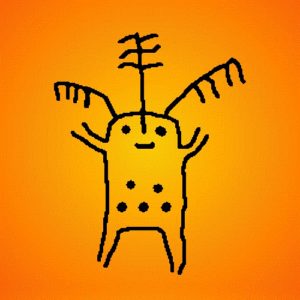

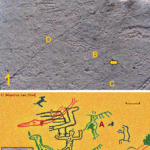
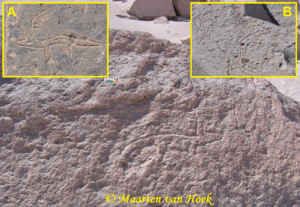
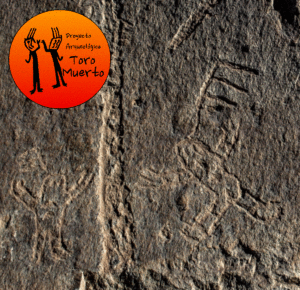
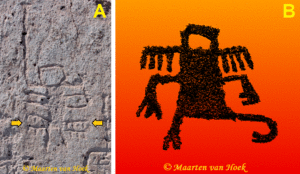
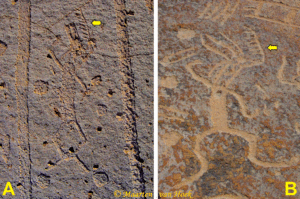
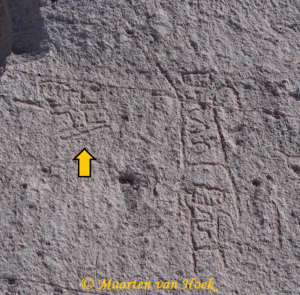
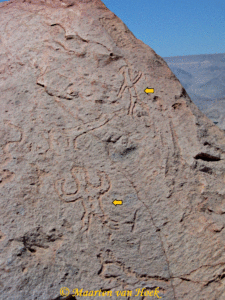
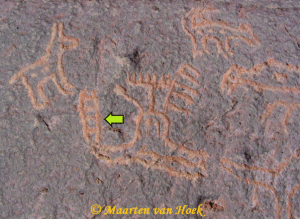
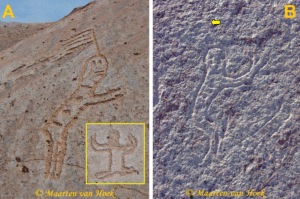
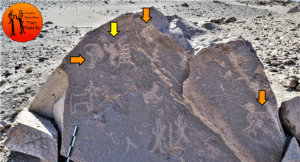
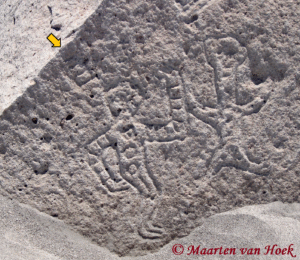
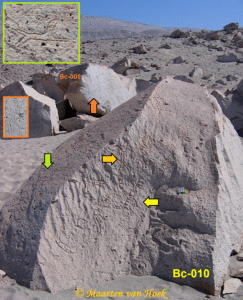
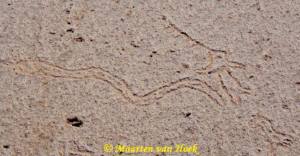
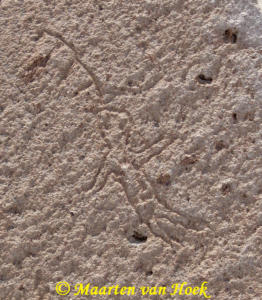
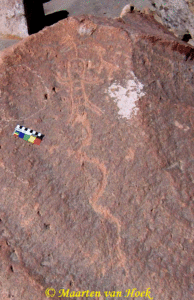
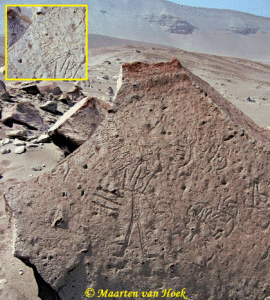
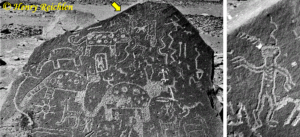
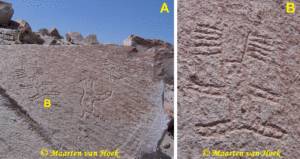

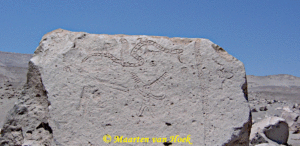
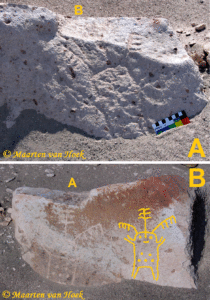
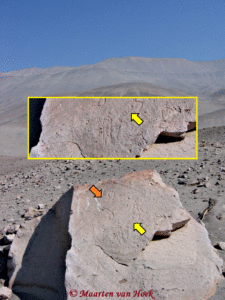
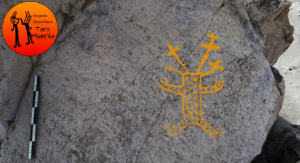
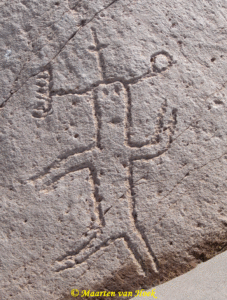
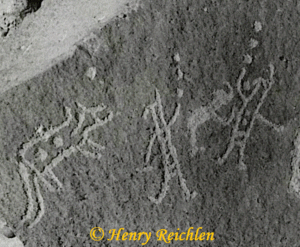
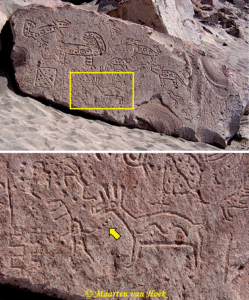
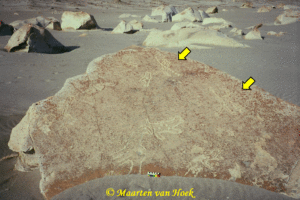
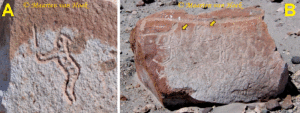
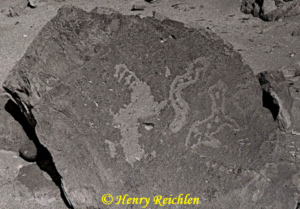
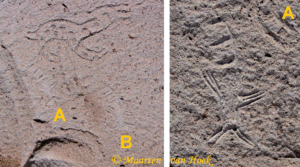
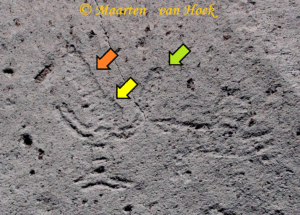
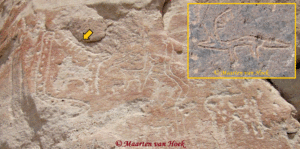
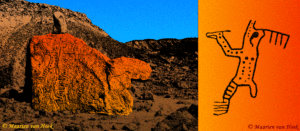
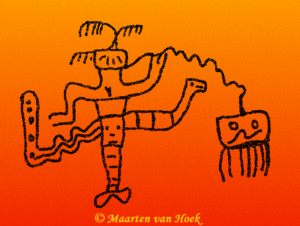
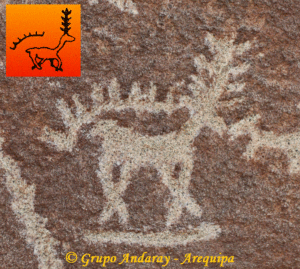
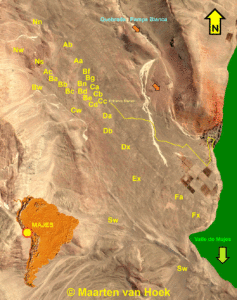
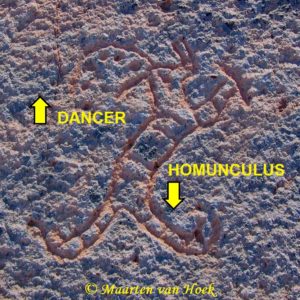
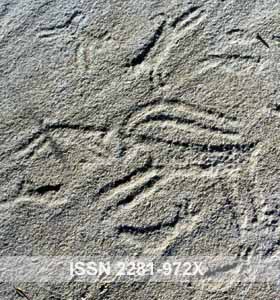













Leave a Reply